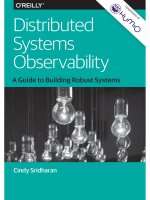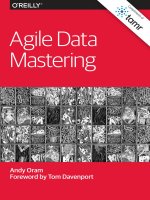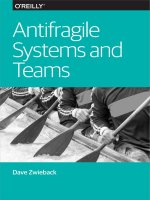IT training marklogic cookbook implementing xquery khotailieu
Bạn đang xem bản rút gọn của tài liệu. Xem và tải ngay bản đầy đủ của tài liệu tại đây (16.01 MB, 43 trang )
Co
m
pl
im
en
ts
of
MarkLogic
Cookbook
Implementing XQuery: Practical
Solutions to Real-World Problems
Part 1
Dave Cassel
MarkLogic Cookbook
Implementing XQuery: Practical
Solutions to Real-World Problems
David M. Cassel
Beijing
Boston Farnham Sebastopol
Tokyo
MarkLogic Cookbook
by Dave Cassel
Copyright © 2017 O’Reilly Media, Inc. All rights reserved.
Printed in the United States of America.
Published by O’Reilly Media, Inc., 1005 Gravenstein Highway North, Sebastopol, CA
95472.
O’Reilly books may be purchased for educational, business, or sales promotional use.
Online editions are also available for most titles ( For more
information, contact our corporate/institutional sales department: 800-998-9938 or
Editor: Shannon Cutt
Production Editor: Kristen Brown
Copyeditor: Sonia Saruba
June 2017:
Interior Designer: David Futato
Cover Designer: Karen Montgomery
Illustrator: Rebecca Demarest
First Edition
Revision History for the First Edition
2017-06-09: Part 1
The O’Reilly logo is a registered trademark of O’Reilly Media, Inc. MarkLogic Cook‐
book, the cover image, and related trade dress are trademarks of O’Reilly Media, Inc.
While the publisher and the author have used good faith efforts to ensure that the
information and instructions contained in this work are accurate, the publisher and
the author disclaim all responsibility for errors or omissions, including without limi‐
tation responsibility for damages resulting from the use of or reliance on this work.
Use of the information and instructions contained in this work is at your own risk. If
any code samples or other technology this work contains or describes is subject to
open source licenses or the intellectual property rights of others, it is your responsi‐
bility to ensure that your use thereof complies with such licenses and/or rights.
978-1-491-99458-0
[LSI]
Table of Contents
Foreword. . . . . . . . . . . . . . . . . . . . . . . . . . . . . . . . . . . . . . . . . . . . . . . . . . . . . . v
Introduction. . . . . . . . . . . . . . . . . . . . . . . . . . . . . . . . . . . . . . . . . . . . . . . . . . vii
1. Peak Performance. . . . . . . . . . . . . . . . . . . . . . . . . . . . . . . . . . . . . . . . . . . 1
Assert Query Mode
Fast Distinct Values
1
3
2. Fun with Maps. . . . . . . . . . . . . . . . . . . . . . . . . . . . . . . . . . . . . . . . . . . . . . 5
Check Whether Two Maps Are Equal
Find the Intersection of a Sequence of Maps
Apply a Function to All Values in a Map
5
6
8
3. Document Security. . . . . . . . . . . . . . . . . . . . . . . . . . . . . . . . . . . . . . . . . 11
List User Permissions on a Document
Get Permissions with Role Names
11
12
4. Working with Documents. . . . . . . . . . . . . . . . . . . . . . . . . . . . . . . . . . . . 17
Generate a Unique ID
Find Binary Documents
Find Recently Modified Binary Documents
17
18
19
5. The Task Server. . . . . . . . . . . . . . . . . . . . . . . . . . . . . . . . . . . . . . . . . . . . 23
Cancel Active Tasks on the Task Server
Cancel Active and Queued Tasks on the Task Server
23
26
iii
6. Administration. . . . . . . . . . . . . . . . . . . . . . . . . . . . . . . . . . . . . . . . . . . . . 29
Find Hostnames in a Cluster
Find Current and Effective MarkLogic Versions During
Rolling Upgrade
iv
|
Table of Contents
29
30
Foreword
This book comes at MarkLogic from the opposite direction of my
own book, Inside MarkLogic Server (recently updated by Mike
Wooldridge). In my book, I aimed to describe MarkLogic’s internals:
its data model, indexing system, and operational behaviors. I made
the decision to avoid getting into how exactly to accomplish specific
goals, because to do so would have to be a book of its own.
This is that book!
In MarkLogic Cookbook, Dave documents a set of MarkLogic rec‐
ipes: ways to do common things that can be a bit too tricky to
remember without a reference by your side. This first installment
covers XQuery. Over time, this book will issue additional install‐
ments with more recipes and topics.
What you’ll find here today is:
• Getting the best performance
• Manipulating maps with the map:map data type
• Viewing security details on documents
• Managing tasks on the Task Server
We hope you enjoy it. If you have your own ideas (favorite tricks!)
that you think should be included in future installments, please send
them to
— Jason Hunter
Somewhere over the Pacific Ocean
April 2017
v
Introduction
MarkLogic is a powerful multi-model database platform with a very
broad set of capabilities—all designed to help you integrate data
from silos faster. It does take some time to learn how to harness that
power, though. The recipes in this book will move you along this
process faster—you can learn from others who have taken the time
to learn how to get the most out of MarkLogic, and add some of
their tools to your toolbelt.
In this, the first volume of a three-part series, we are covering
XQuery recipes. For much of MarkLogic’s history, XQuery was the
primary language used to interact with MarkLogic (more recently,
MarkLogic has added support for JavaScript). This W3C-standard
functional language is well-suited for working with hierarchical data
structures, like XML, which in turn is a descriptive medium for
describing document data.
Recipes are a useful way to distill simple solutions to common prob‐
lems—copy and paste these into MarkLogic’s Query Console or
your source code, and you’ve solved the problem. In choosing rec‐
ipes for this book, I looked for a couple of factors. First, I wanted
problems that occur with some frequency. Some problems in this
book are more common than others, but all occur often enough in
real-world situations that one of my colleagues wrote down a solu‐
tion. Second, I looked for techniques that aren’t commonly known,
such as using the fn:fold-left function when working with a
sequence of maps. Finally, some recipes require explanations that
provide insight into how to approach programming with Mark‐
Logic. Each recipe provides some combination of these factors.
vii
Developers will get the most value from these recipes and the
accompanying discussions after they’ve worked with MarkLogic for
at least a few months and built an application or two. If you’re just
getting started, I suggest spending some time on MarkLogic Univer‐
sity classes first, then come back to this material.
The recipes in this book were submitted by a variety of MarkLogic
employees: sales engineers, who demonstrate the value of Mark‐
Logic; consultants, who work with customers to build production
applications; and members of the Engineering team, who build
MarkLogic Server itself. Check />recipes for additional recipes or to suggest your own to the broader
community.
Acknowledgments
My thanks to Diane Burley, for doing the hounding necessary for
me to have a shot at my deadlines.
I’d like to thank the many members of the MarkLogic Community
who contributed recipes, including Bill Holmes, Tyler Replogle,
Jason Hunter, Paxton Hare, Geert Josten, Mark Plotnick, and Julio
Solis.
viii
|
Introduction
CHAPTER 1
Peak Performance
Many MarkLogic installations store large amounts of data, but still
provide fast searches. The key to performance is understanding how
MarkLogic works—specifically understanding query and update
modes, and the use of indexes. These two recipes help ensure you’re
getting the speed you need for your applications.
Assert Query Mode
Problem
All MarkLogic requests run in either query or update mode, based
on a static analysis of the code. The mode is important, because
query requests are able to run without locking database content.
Accidentally running in update mode is a common cause of requests
running slower than expected.
Verify that a MarkLogic statement is running in query mode.
Solution
Applies to MarkLogic versions 7 and higher
Place this snippet as early in the code path as you can to make sure it
is executed before MarkLogic spends too much time on other parts
of your request:
let $assert-query-mode as xs:unsignedLong :=
xdmp:request-timestamp()
1
If a request that includes this line is run in update mode, then this
error will be thrown:
> XDMP-AS: (err:XPTY0004) let $assert-query-mode as
xs:unsignedLong := xdmp:request-timestamp() -- Invalid coercion:
() as xs:unsignedLong
Discussion
Sometimes MarkLogic’s static analysis may see something that trig‐
gers update mode, even if that was not the developer’s intent. The
code in this recipe will throw an exception if it is run as an update,
making it easy to notice the problem. Once this problem has been
seen, find the code that caused the statement to run as an update. If
the statement really should be running as an update, remove the
assertion. If the update can be removed or isolated into an
xdmp:invoke() call, do that to allow the statement to run as a query.
Using this function, we can specify the different-transaction
option, causing the update to be separated from the main request.
See the Transaction Type section of the Application Developer’s
Guide for more information about query or update modes.
Note that we don’t need the same approach for Server-side Java‐
Script (SJS). With SJS, there is no static analysis; the developer must
explicitly declare update mode.
It’s important to see that we can’t just call xdmp:requesttimestamp() and get the same effect. The magic is in the as
xs:unsignedLong—because that clause is present, MarkLogic will
expect the value to be an unsigned long, or convertible to one. If the
code returns the empty sequence, the conversion can’t happen, and
the error is thrown.
The name is important too, in order to be self-documenting. What
we don’t want to happen is that a developer runs into this exception
and realizes that it can be “fixed” by removing the as xs:unsigned
Long, or by changing it to as xs:unsignedLong? (making it
optional). The presence of the word assert in the name provides a
clue that we’re expecting something here, and silencing the message
would be contrary to the original developer’s intent.
What do you do if this exception gets thrown? If that’s happening,
MarkLogic sees that updates might be made. Check whether those
updates can be made in a different transaction using xdmp:invoke or
2
|
Chapter 1: Peak Performance
xdmp:invoke-function. Consider whether those updates need to be
made at all. If updates really should be part of a request, you can
remove the assertion—but make sure you aren’t locking too many
documents.
Fast Distinct Values
Problem
You want to quickly find the distinct values in a particular element
or JSON property.
Solution
Build a range index on the element or property, then call:
let $ref :=
(: call one of the cts:*-reference functions to create a
reference to your index
:)
return cts:values($ref)
Required Index
Range index on the target element or property.
Discussion
Wanting a list of the distinct values in an element or property is a
common problem. Developers who are new to MarkLogic often
turn to fn:distinct-values(), like this:
fn:distict-values(/content/author/full-name)
While this approach will work fine for small numbers of values, it
doesn’t scale. As written, MarkLogic will retrieve all fragments that
the /content/author/full-name path matches, put the full-name
elements into a sequence, and pass that to fn:distinct-values().
Because distinct-values expects a sequence of strings, each ele‐
ment is converted to a string. The function will then loop through
each string it was given in order to find the unique values.
Consider a database that has just 1,000 matching documents, but
just 10 distinct values. Even such a small example is enough to illus‐
trate how much effort MarkLogic has to waste by loading all 1,000
fragments to get just those 10 values. To see how many fragments
Fast Distinct Values
|
3
MarkLogic would need to load to answer this query on your data,
run this in Query Console: xdmp:plan(/content/author/fullname), substituting your XPath for /content/author/full-name.
Conversely, if a range index is available, then the work has already
been done. An element range index on full-name, or a path range
index on /content/author/full-name, will have a list of distinct
values, along with identifiers of fragments that hold the values. By
calling cts:values(), we directly access the index and don’t need to
load any of the fragments.
4
|
Chapter 1: Peak Performance
CHAPTER 2
Fun with Maps
Maps (known as associative arrays in some languages) are a useful
data structure, allowing fast, key-based access to a value. MarkLogic
provides a common set of map operators, but the recipes in this
chapter make them even easier to work with.
Check Whether Two Maps Are Equal
Problem
Sometimes you need to see if two maps are equal, but don’t want to
loop through all the keys and compare them. If you do an equals
(=), you’ll get an error called XDMP-COMPARE saying “Items not
comparable.”
Solution
Applies to MarkLogic versions 7 and higher
If you serialize the map into XML, then you can use fn:deepequal(). Here is an example of how this can be done:
let $mapA :=
map:new((
map:entry("a", "aardvark"),
map:entry("b", "badger")
))
let $mapB :=
map:new((
map:entry("a", "aardvark"),
5
map:entry("b", "badger")
))
let $mapC :=
map:new((
map:entry("c","candidate")
))
return
(
(: ($mapA eq $mapB), will cause the XDMP-COMPARE error :)
fn:deep-equal(<x>{$mapA}</x>, <x>{$mapB}</x>),
fn:deep-equal(<x>{$mapA}</x>, <x>{$mapC}</x>)
)
Discussion
MarkLogic represents maps as XML, so:
map:new((
map:entry("a", "aardvark"),
map:entry("b", "badger")
))
becomes:
<map:map xmlns:map=" />xmlns:xsi=" />xmlns:xs=" /><map:entry key="b">
<map:value xsi:type="xs:string">badger</map:value>
</map:entry>
<map:entry key="a">
<map:value xsi:type="xs:string">aardvark</map:value>
</map:entry>
</map:map>
With that XML representation, fn:deep-equal() is able to make the
comparison.
Find the Intersection of a Sequence of Maps
Problem
The intersection of two maps is the set of key/value pairs that are the
same in both maps. To find the intersection of two maps, you can
use the map intersection operator (*), like this: $mapA * $mapB. But
what if you have an arbitrarily long sequence of maps?
6
|
Chapter 2: Fun with Maps
Solution
Applies to MarkLogic versions 7 and higher
This is where folding becomes very handy. The fn:fold-left func‐
tion applies an operation to a sequence of values:
declare function local:intersect($maps as map:map*)
as map:map* {
fn:fold-left(
function($left, $right) { $left * $right },
fn:head($maps),
fn:tail($maps)
)
};
let $mapA :=
map:new((
map:entry("a", "aardvark"),
map:entry("b", "badger")
))
let $mapB :=
map:new((
map:entry("a", "aardvark"),
map:entry("b", "badger"),
map:entry("d", "duck")
))
let $mapC :=
map:new((
map:entry("a", "aardvark"),
map:entry("b", "badger"),
map:entry("c", "candidate")
))
return
(
local:intersect(($mapA, $mapB, $mapC))
)
The result is:
<map:value xsi:type="xs:string">badger</map:value>
</map:entry>
<map:entry key="a">
<map:value xsi:type="xs:string">aardvark</map:value>
</map:entry>
</map:map>
Find the Intersection of a Sequence of Maps
|
7
Discussion
The fn:fold-left() function applies a function to a series of val‐
ues, with the result of one operation being input to the next. For
instance:
fn:fold-left(
function($left, $right) { $left + $right },
1,
(2, 3)
)
This applies the specified function to the 1 and the first item in the
sequence, 2. These are added together, producing 3. That accumula‐
ted value and the next value in the sequence are then passed to the
function. The new accumulated value becomes 3 + 3 = 6. The
sequence is empty now, so fn:fold-left is finished.
With the maps, the local:intersect() function will use the inter‐
sect operator (“*”) to combine $mapA and $mapB, then combine that
result with $mapC.
Apply a Function to All Values in a Map
Problem
Generate a new map by applying a function to each value in a map.
Solution
Applies to MarkLogic versions 7 and higher
The local:apply-to-map() function takes a function to apply to
each value, as well as a map to work on:
declare function local:apply-to-map(
$function as xdmp:function,
$mapIN as map:map
) as map:map
{
map:new(
(: Uses the simple map operator; see discussion below :)
map:keys($mapIN) !
map:entry(., xdmp:apply($function, map:get($mapIN, .)))
)
};
declare function local:plus-one($n)
8
|
Chapter 2: Fun with Maps
{
$n + 1
};
(: example run :)
let $map :=
map:new((
map:entry("foo", 1),
map:entry("bar", 2),
map:entry("stuff", 3),
map:entry("nonsense", 4)
))
return local:apply-to-map(
xdmp:function(xs:QName("local:plus-one")),
$map
)
Discussion
In XQuery, as in a number of other languages, functions are items
that we can pass around. This allows us to set up a function that will
apply another function in some way. In this case, we’re looping
through the keys of an input map, applying the specified function to
each value.
Notice that the function returns a new map with the changed values.
It’s also possible to write a function like this that will modify the map
in place, but returning a new map is more in keeping with func‐
tional programming.
The function to be applied can do whatever you want. The key ele‐
ment is that it needs to take a single value and return a new value. In
the example, these values are simple numbers, but they could be
XML nodes, sequences, strings, or whatever your application calls
for. The key line in local:apply-to-map is:
map:keys($mapIN) !
map:entry(., xdmp:apply($function, map:get($mapIN, .)))
This line uses the simple map operator (!), which applies some code
to each item in a sequence. The same line can be written as a
FLWOR statement, which is equivalent, but a bit less succinct:
for $item in map:keys($mapIN)
return
map:entry($item,
xdmp:apply($function, map:get($mapIN, $item)))
With the simple map operator, the period acts as the current item.
Apply a Function to All Values in a Map
|
9
CHAPTER 3
Document Security
MarkLogic provides a robust, role-based security model. Most of the
functions expect to work with the IDs of roles or users, but names
are much easier for humans to process. These recipes provide easier
insight into who can see what.
List User Permissions on a Document
Problem
You want a list of a particular user’s permissions on a document.
Solution
Applies to MarkLogic versions 7 and higher
The xdmp:document-get-permissions() function will get all per‐
missions, but you can narrow this down after identifying the user’s
roles:
let $roles := xdmp:user-roles("some-user")
return
xdmp:document-get-permissions("/content/some-doc.json")
[sec:role-id = $roles]/sec:capability/fn:string()
The result will be a sequence of permission strings from among
read, update, insert, and execute.
11
Discussion
Permissions are assigned to a document by role. Users are also
assigned roles, and through them gain access to documents.
The first step of this recipe is to gather the roles that the specified
user has. The xdmp:user-roles() function returns both the roles
that the user has been directly granted and any inherited roles.
With the roles in hand, we can retrieve all the permissions on the
target document, then use some XPath to retrieve just the ones we
are interested in.
Note that the sec namespace is available by default—you do not
need to declare it.
Get Permissions with Role Names
Problem
Get the permissions on a document, decorated with the names of
the roles.
Solution
Applies to MarkLogic versions 7 and higher
We want to get not just the IDs of the roles, but their names as well.
This requires calling sec:get-role-names(), which must be run
against the Security database. However, xdmp:document-getpermissions() must be run against the database containing the
document about which we want the information.
import module namespace sec=" />at "/MarkLogic/security.xqy";
declare function local:dump-perms($uri)
{
for $perm in xdmp:document-get-permissions($uri)
let $role-name :=
xdmp:invoke-function(
function() {
try {
sec:get-role-names($perm/sec:role-id)
}
catch($ex) {()}
},
<options xmlns="xdmp:eval">
12
|
Chapter 3: Document Security
<database xmlns=" />xdmp:security-database()
}</database>
</options>
)
return
id="{$perm/sec:role-id}"
name="{$role-name}"
capability="{$perm/sec:capability}"></role>
};
local:dump-perms("/content/doc1.json")
Sample Output
(
)
Required Privileges
• />• />
Discussion
When we get permissions for a document, we typically get some‐
thing like this:
(
<sec:permission>
<sec:capability>read</sec:capability>
<sec:role-id>324978243</sec:role-id>
</sec:permission>,
<sec:permission>
<sec:capability>read</sec:capability>
<sec:role-id>32493478578243</sec:role-id>
</sec:permission>,
<sec:permission>
<sec:capability>update</sec:capability>
<sec:role-id>32493478578243</sec:role-id>
</sec:permission>
)
That provides the essential information, but to be useful to people,
we really need the role names, not just the IDs. This recipe looks up
Get Permissions with Role Names
|
13
the names. sec:get-role-names() gives us the role names, with the
requirement that the function be run against the Security database.
In order to do that, we’re calling xdmp:invoke-function(). We
could have used xdmp:eval() here; either function allows us to run
a block of code in a different execution context. There’s a big advan‐
tage to invoke: the function has access to the local variables, so we
don’t need to pass in the role ID to look up as an external variable, as
we would with xdmp:eval. We also avoid having code in a string,
which is generally harder to maintain.
Notice the try/catch. sec:get-role-names() will throw an error if
called with a role ID that is not in the Security database. How can
this happen?
Suppose we have a role, role-1. We insert a document, giving role-1
read and update permissions:
xquery version "1.0-ml";
xdmp:document-add-permissions(
"/example.xml",
(xdmp:permission("role-2", "read"),
xdmp:permission("role-2", "update"))
)
Right now, if we run the recipe above, here’s the output we get:
name="role-2"
name="role-2"
name="role-1"
name="role-1"
Now suppose that role-1 gets deleted, due to changing security
requirements or implementation. When a role is deleted, it is
removed from all users, and the record of it is removed from the
Security database. However, the indexes are not updated to reflect
that the role no longer exists—doing so could be a very large opera‐
tion if the role had permissions on many documents. Note that this
is not a security problem, because no user has that role anymore.
However, it does mean that our document still lists permissions for
this orphaned role. If an invalid ID gets passed to sec:get-rolenames(), then the function will throw an error. This is why we have
the try/catch in place: to allow us to continue gathering information
14
|
Chapter 3: Document Security
on known roles. After removing role-1, here is the result of calling
the recipe:
name="role-2"
name="role-2"
name=""
name=""
The empty name indicates an orphaned role. If we prefer to sup‐
press those results, we can add where $role-name ne "" to the
FLWOR statement. We can also use this to discover orphaned roles,
which can be cleaned up by using xdmp:document-setpermissions() with the valid ones.
Get Permissions with Role Names
|
15









